 |
Interlocking gates. Once common in
Victoria, these gates were worked from a wheel in a nearby signal box. These
examples were at Kyneton, Vic.
were the last ones left still operated
this way. They were interlocked with the signals, so that they couldn't be
closed across the railway if the signals were at proceed. or more
accurately, the signals couldn't be set to clear unless the gates were
closed across the road. |
|
 |
Wig Wag signal. A type of signal which
swung back and forth with a red light and bell. They were used in Victoria,
South Australia and Western Australia. As yet, I'm not aware of them being
in use in other states. Coal Creek Historical Park, Korrumburra, Vic. |
 |
Hand operated gates. New South Wales
often used farm type gates for level crossings. These examples were at
Cootamundra, NSW. |
 |
Mechanically operated boom gates. I don't
believe these were terribly common, but the gates seen here were operated
from the signal box by cable. Presumably connected to a wheel or lever.
South Maitland Railway,
East Greta Junction,
Telarah, NSW. |
 |
Boom gates. I managed to see these just
in time. Note the new FL signals ready to be installed. These gates made a
loud hiss as they opened and closed. Possibly operated pneumatically. I'm
ready to be corrected if you know otherwise. Newcastle, NSW. |
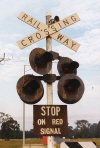 |
Flashing Light Signal - Victoria. Old
example of a Flashing Light (FL) signal in Victoria. This one was on the
former private line to a paper mill in Gippsland. It has since been replaced
with a more modern signal. This one was unusual in having a continuously
ringing bell, rather like an alarm. The STOP ON RED SIGNAL sign is also
rather home made looking. The top set of lights were redundant as the
alignment they faced was replaced by a roundabout. Maryvale, Vic. |
 |
FL signals - Tasmania. Tasmanian FL
signals had yellow poles, but were otherwise identical to other states. This
one guards the Tasrail mainline and the one in the background is for the Emu
Bay Railway. Burnie, Tas. |
|
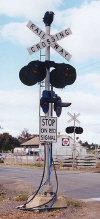 |
FL signals - South Australia. An example
of a South Australian FL signal. Much the same as elsewhere, but with a
ladder on the pole.
These ones had been recently installed which explains the loose cables.
Bordertown, SA. |
|
 |
FL signal and boom gate - New South Wales.
Boom gates were much the same from state to state until recent years.
This one has the lights hanging above the boom (when closed) as I recall
they used to be in Victoria. I notice it also opens almost vertical.
Something rarely seen elsewhere. This one and its twin were operated
manually by switches in the signal box. Cootamundra, NSW. |
|
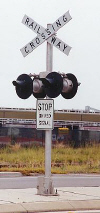 |
 |
FL signal - NSW. This signal was unusual (to me) as
it was the first time I'd seen the white background STOP ON RED SIGNAL
signs, which are now the Australian standard (apparently). I don't think the
black ones are in danger of disappearing too soon however.
The other unusual part were the odd shaped pieces under the visors (click on
the close-up). I assume they are to make the lights easier to see when the
sun is low.Kooragang Island, NSW. |
 |
FL signal - Queensland.
Red background rectangular crossing sign
on a Queensland flashing light (FL) signal. Note black on white STOP ON RED
SIGNAL sign. Also note pedestrian signals (many Queensland crossings do not
have bells) and the sign underneath the pedestrian signal showing a steam
train pictogram So, rather apt that one is crossing here. Toowoomba Qld.
Paul Tiffany photo. |
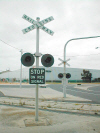 |
FL signal - Victoria. Example of a
typical 1980's FL signal. This one is on the disused Webb Dock line.
Fisherman's Bend, Vic. |
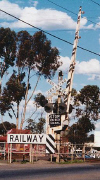 |
FL signal and boom gate - Victoria. Now
that boom gates in Victoria have been repainted red and white, I took the
opportunity to take this photo of the last time I saw a black and white boom
gate still with the chevron shaped white reflective strips in the centre of
the black sections. Most had been replaced by round reflectors by the
1990's. Sunbury, Vic. |
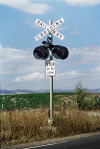 |
FL signal with strobe - Tasmania. This FL
signal in Tasmania uses a strobe light for extra emphasis on the flashing
red lights. Photo: Rob Mathews of
Hand Made Accessories. |
 |
The Red / Green Show. There'll be more on
the subject of railway crossings at intersections with traffic lights on
this site later. But for now, here's a photo of the set-up at Yarragon, Vic.
When a train is approaching, the signals on the far side of the
crossing turn green (with arrow) to clear the crossing of any vehicles
stopped over it. The signals on the near side remain red. The problem is
that traffic stopped at the stop line can't see them and crosses anyway.
Also, traffic from the side street to the left can't see them or the red
arrow facing the street either (they're too busy looking right for other
traffic). |
